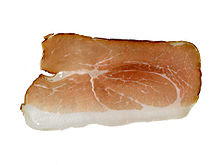Black Forest ham
Black Forest ham (German: Schwarzwälder Schinken) is a variety of dry-cured smoked ham produced in the Black Forest region of Germany. Since 1997, it can only be made in a well-defined geographical area. In the case of Black Forest ham, the salting, and curing needs to be done in the Black Forest. Most of the pigs used come from other regions of Germany, or the European Union. This only applies to the European Union, though. In the United States and Canada, there are different kinds of ham which are sold as Black Forest ham: These are usually produced locally, and very often, the methods of producing them are different from the original of the Black Forest.


In 2018, about 6. 1 million tons were produced. About 85 percent was sold through discount stores, about ten percent was sold through specialized retailers, and the remaining fice percent was sold through restaurants.
Preparation
changeRaw ham is salted and seasoned with garlic, coriander, pepper, juniper berries and other spices. After curing for two to three weeks, the salt is removed and the ham aged an additional two weeks. It is then cold-smoked using "local conifers and sawdust" at around 25 °C (77 °F) for several days. It ripens in an air-conditioned room for several weeks, becoming almost black on the outside and acquiring much of its distinctive flavor. As a result it usually tastes very salty.
Characteristics
changeBlack Forest ham is boneless and about one-fifth fat. It has a very pronounced flavor and is common in German cuisine. It may be eaten fresh, for example on Holzofenbrot or rye bread, with fruit, or used as an ingredient in cooked dishes. Whole pieces of Black Forest ham can be preserved for months when stored properly. It is typically served at room temperature.
Related product
changeBlack Forest bacon (German: Schwarzwälder Speck) is bacon produced the same way, and comes in two categories: Durchwachsener Speck has several layers of meat, and half of it is fat; fetter Speck is almost completely fat. Both variants include the skin, called pork rind. The pork rind is too hard to eat, but it is cooked in some traditional German dishes, such as Linsen mit Spätzle or Eintopf, to add its flavors to the food.
Unlike Black Forest ham, this is not a protected designation.
Related pages
change- Prosciutto - Italian ham